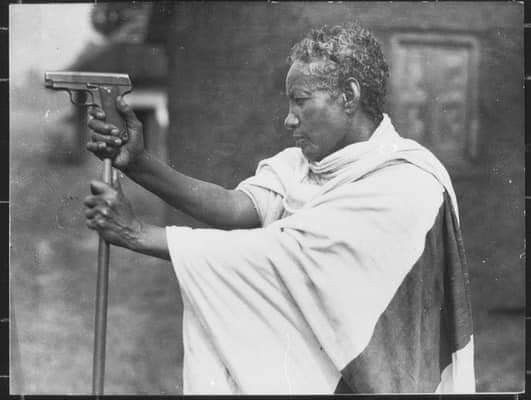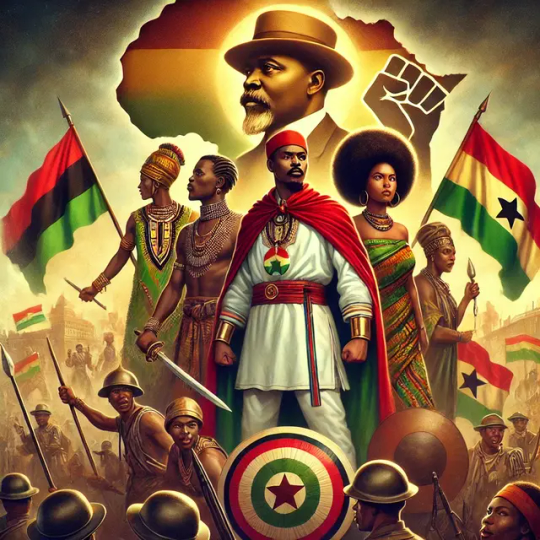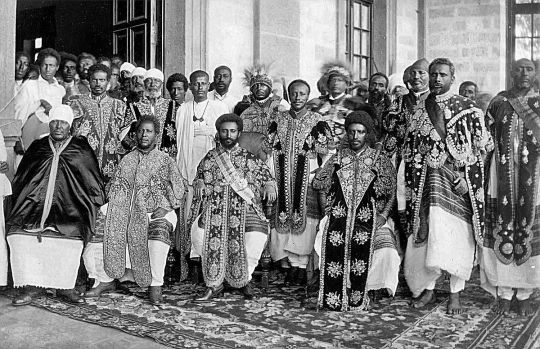#Emperor Haile Selassie
Explore tagged Tumblr posts
Text

Abyssinian woman of 60 who killed 50 Italians at Adowa will fight again . Farlenekh , and old Abyssinian woman who fought in the battle of Adowa and saw Italy crushingly defeated 40 years ago , has asked Emperor haile Selassie for a mule and a rifle so that she can again fight the Italians in the Ogaden . 26 September 1935, Addis Ababa Ethiopia
#Addis Ababa#Ethiopia#Ogaden#War#Hero#Warrior#African#Battle of Adowa#Italy#Emperor Haile Selassie#Boss
161 notes
·
View notes
Text

(Via Gebre Menfes Kidus)
#The Kingdom of God is a Monarchy#Lord Jesus Christ#King of kings#Orthodox Christian#Ethiopean Tewahedo#Emperor Haile Selassie
2 notes
·
View notes
Text

I heard whispers about this a while back and was looking forward to it. As an African history buff with a particularly deep thirst for knowledge about the post colonial period this one was a must see. The story centers around the grand daughter of the Late great honorable Hailie Sellasie and her experiences prior to and after the toppling of the emperors kingdom. The movie works because it manages to weave a tapestry of intimate interviews with family members, historians, Ethiopian citizens and other supporters and backers of the royal family you are swept into a world of profound privilege and gut wrenching suffering. Prior to this documentary I was very grounded in the fact that the Emperor was an indifferent monarch swimming in opulence while his people where suffering from a famine. This documentary forces me to question that narrative, because we are experiencing everything from the perspective of family members who themselves got victimized by the regime that took over from the Emperor. Ultimately this is an intimate portrait of societal trauma, and how the foundational myths of certain nation states can leave a lot of things unsaid and leave people with deep deep wounds. As a work of visual entertainment I think this is up there because the found footage is arresting, and the interviews are emotionally deep.
4 notes
·
View notes
Text

youtube
#chef#cake#Haile Selassie#ethiopia#emperor#california#food#boat#1967#ታሪካችን#Alan Scaffardi#control#topic#papik#Youtube
0 notes
Text

African Resistance Movements Against Colonialism: A Garveyite Perspective
“Rise Up, Ye Mighty Race!”—The Spirit of Resistance and Liberation
Introduction: The Garveyite Lens on African Resistance
Marcus Garvey, the great Pan-Africanist and leader of the Universal Negro Improvement Association (UNIA), championed African self-determination, unity, and economic independence. His teachings emphasized that colonial rule was not merely a political imposition but a spiritual and economic stranglehold that sought to erase African sovereignty and dignity.
From a Garveyite perspective, African resistance to colonialism was not just about territorial control—it was about reclaiming African identity, self-sufficiency, and the destiny of the Black race. The heroes of these movements were not just warriors but visionaries who embodied Garvey’s call: “Africa for the Africans, those at home and those abroad!”
1. Early Resistance: Fighting for Ancestral Lands and Autonomy
Before European colonization took full control, African kingdoms and societies fiercely resisted foreign domination. Many of these struggles were aligned with Garvey’s ideals of self-reliance and strong leadership.
The Ashanti Wars (1823–1900, Ghana): The Ashanti Empire, led by rulers such as Asantehene Prempeh I and Queen Yaa Asantewaa, waged multiple wars against the British. Yaa Asantewaa’s leadership in the 1900 War of the Golden Stool exemplified the defiant spirit Garvey championed: African women and men leading their own struggles, refusing foreign rule.
The Zulu Resistance (1879, South Africa): Under King Cetshwayo, the Zulu military defeated British forces at the Battle of Isandlwana, a powerful example of African strategic brilliance. Garvey would have seen this as proof that African people, when united, could stand against European imperial forces.
The Maji Maji Rebellion (1905–1907, Tanzania): A widespread uprising against German rule, where different ethnic groups united under spiritual leadership. It echoed Garvey’s belief in unity as the key to liberation.
These wars proved that Africa was never passively colonized. The struggle for sovereignty was present from the beginning.
2. Pan-Africanism and the Rise of Organized Resistance
As colonial rule tightened, African resistance evolved into more structured political movements. This shift aligned with Garvey’s vision of a global African awakening.
The Ethiopian Resistance (1935–1941): Emperor Haile Selassie’s defiance against Mussolini’s invasion of Ethiopia was a monumental moment for Pan-Africanists worldwide. Garvey saw Ethiopia as a symbol of unbroken African sovereignty, and Selassie’s resistance was a rallying cry for Black liberation worldwide.
The Mau Mau Uprising (1952–1960, Kenya): The Kikuyu-led Mau Mau rebellion against British rule was one of the most militant anti-colonial struggles. It embodied Garvey’s call for Africans to seize their freedom by any means necessary.
The Liberation of Ghana (1957): Kwame Nkrumah’s leadership in achieving Ghanaian independence was a direct continuation of Garvey’s ideals. Nkrumah, deeply influenced by Garveyism, declared: “The independence of Ghana is meaningless unless it is linked up with the total liberation of the African continent.”
These movements reflected Garvey’s belief that African unity and self-determination were inevitable forces that colonial powers could not suppress forever.
3. The Role of African Diaspora and Garvey’s Influence
Garveyism was not just a philosophy—it was a movement that connected the struggles of Africans on the continent with those in the diaspora.
Caribbean and American Influence on African Liberation: Many African revolutionaries were inspired by Pan-Africanist movements in the Caribbean and the U.S. Leaders like Jomo Kenyatta (Kenya), Julius Nyerere (Tanzania), and Nkrumah (Ghana) studied abroad, where they encountered Garvey’s teachings and applied them to their home struggles.
UNIA’s Impact on Black Consciousness: Garvey’s UNIA spread ideas of African nationalism, economic self-reliance, and military resistance. His vision of a self-sufficient Africa influenced independence leaders and fueled anti-colonial activism.
The Back-to-Africa Movement: While most Africans did not physically return to Africa, Garvey’s message inspired a psychological return—one that led to a reconnection with African identity, history, and the fight for sovereignty.
The African resistance movements were never isolated struggles. They were part of a global Black awakening, demanding not just freedom from colonial rule but also a reclamation of dignity and economic power.
4. Lessons from Garvey for Today’s Africa
Garvey’s vision remains as relevant today as it was during colonial rule. As Africa continues to navigate neocolonialism—economic exploitation, foreign influence, and internal divisions—the core Garveyite principles remain essential:
Economic Self-Reliance: True liberation means controlling resources, industries, and trade. Modern African nations must prioritize building strong, independent economies rather than relying on foreign aid.
Pan-African Unity: Colonial borders divided Africa, but unity remains the key to true independence. Regional alliances like the African Union must embrace Garvey’s radical call for continental solidarity.
Cultural Reclamation: Garvey understood that mental liberation was as crucial as political liberation. Africa must continue reclaiming its history, languages, and cultural pride to fully escape the psychological chains of colonialism.
Conclusion: The Struggle Continues
Garvey’s cry—"Up, you mighty race, accomplish what you will!"—remains a guiding light. The resistance against colonialism was never just about defeating European powers; it was about the restoration of African sovereignty, pride, and unity. The struggle continues today in economic policies, cultural narratives, and the fight against neo-colonial forces.
Garveyite thought reminds us that true liberation is not just about removing the colonizer’s physical presence—it’s about ensuring that Africa stands tall, self-sufficient, and united in its destiny.
Africa for the Africans—Yesterday, Today, and Forever!
#african resistance#black resistance#black history#black people#blacktumblr#black#black tumblr#pan africanism#black conscious#africa#black empowering#black power#blog#marcus garvey#Garveyism#Garveyite#decolonization#black liberation#african history
148 notes
·
View notes
Text



Ah yes, typical methods of imperial conquest and expansion.

Another typical Napoleonic action: whooping Italy's behind!!!

A WILD ENCOUNTER! Rimbo is that you!?!?!?! Did you write any poems about Ras Makonnen?!

Modern-day Ethiopia lore...

I think this is a royal personage of Ethiopia who was Haile Selassie's father. (pinterest)
#memes#napoleon bonaparte#ras makonnen#isthisnapoleoncute?/j#i mean no harm#btw ras makonnen did not become emperor but his son did#haile selassie was coincidentally his second son#so is this a “if the king of rome did become emperor” kind of situation
14 notes
·
View notes
Text

Emperor Haile Selassi I and his wife Empress Menen Asfaw, rulers of the bygone Ethiopian Empire, were crowned on November 2, 1930. Crown prince Asfaw Wossen (right), and the second younger son Makonnen pose beside their parents.
W. Robert Moore
#W. Robert Moore#W Robert Moore#royalty#Haile Selassi#Menen Asfaw#family#people#ethiopia#1930s#africa
126 notes
·
View notes
Text

The term "Rastafari" derives from "Ras Tafari Makonnen", the pre-regnal title of Haile Selassie, the former Ethiopian emperor who occupies a central role in Rasta belief. The term "Ras" means a duke or prince in the Ethiopian Semitic languages; "Tafari Makonnen" was Selassie's personal name. It is unknown why the early Rastas adopted this form of Haile Selassie's name as the basis of the term for their religion. As well as being the religion's name, "Rastafari" is also used for the religion's practitioners themselves. Many commentators—including some academic sources and some practitioners—refer to the movement as "Rastafarianism". However, the term is disparaged by many Rastafari, who believe that the use of -ism implies religious doctrine and institutional organisation, things they wish to avoid.

Ras (Amharic: ራስ, romanized: ras, lit. 'head' compare with Arabic Rais or Hebrew Rosh), is a royal title in the Ethiopian Semitic languages. It is one of the powerful non-imperial titles.
Historian Harold G. Marcus equates the Ras title to a duke;[citation needed] others have compared it to "prince".
The combined title of Leul Ras (Amharic: ልዑል ራስ) was given to the heads of the cadet branches of the Imperial dynasty, such as the Princes of Gojjam, Tigray, Ras Tafari Makonnen and the Selalle sub-branch of the last reigning Shewan Branch, and meaning "Lord of Lords", the highest title of lord.

#ras#african#afrakan#kemetic dreams#brownskin#africans#afrakans#brown skin#african culture#afrakan spirituality#makonnen#tigray#ras tafari#rastafari#harold g marcus#leul ras#lord of lords#Tafari Makonnen#haile selassie#ethiopia#ta netjer#amharic
194 notes
·
View notes
Text

15 notes
·
View notes
Text

(spotted on facebook)
16 notes
·
View notes
Text

John F. Kennedy and Jackie Kennedy attend a welcoming ceremony in Washington D.C. for Ethiopian Emperor Haile Selassie on October 1st, 1963.
#jackie kennedy#john f kennedy#vintage#icons#the kennedys#jackie o#1960s#60s#60s icons#jfk#60s vintage#60s glamour#60s girl#60s hair#60s women#1960s icons#1960s photography#american vintage#american couple#iconic couple#first lady#jackie onassis#jacqueline kennedy#1960s aesthetic#aethetics#fashion icon#vintage americana#high society#elegance#washington dc
101 notes
·
View notes
Text

Audrey Hepburn, Mel Ferrer, and members of Ethiopian emperor Haile Selassie's immediate family at the backstage of Broadway's Ondine, 1954.
#audrey hepburn#1950s#movies#old movies#on the set#old hollywood glamour#old hollywood#fashion#classic#vintage#photography#style#1954#ondine
24 notes
·
View notes



